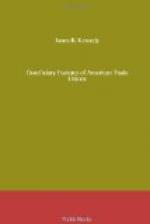=======================================================
========== | Year |Year Sick Benefits Name of Organization. | Organized. | Introduced. ------------------------------------------------------------
----- Granite Cutters ................| 1877 | 1877 Cigar Makers ...................| 1864 | 1880 Typographia ....................| 1873 | 1884 Barbers ........................| 1887 | 1893 Iron Molders ...................| 1859 | 1896 Tobacco Workers ................| 1895 | 1896 Pattern Makers .................| 1887 | 1898 Leather Workers on Horse Goods..| 1896 | 1898 Piano and Organ Workers ........| 1898 | 1898 Boot and Shoe Workers ..........| 1895 | 1899 Garment Workers ................| 1891 | 1900 Plumbers .......................| 1889 | 1903 ------------------------------------------------------------
-----
The Granite Cutters’ Union was the first national union to inaugurate a system of national sick benefits. In its first constitution, 1877, provision was made for the formation of a voluntary association for the payment of sick benefits. All members of the Union under fifty-five years of age were eligible to membership.[122] An initiation fee, varying from two dollars for members under thirty years of age to six dollars for those fifty years old, was charged. The amount of the benefit was fixed at six dollars per week during sickness, without any limitation on the amount granted during any one year. The association never had a large membership and was dissolved in 1888. The Union from 1888 to 1897 exempted members during illness from all dues except funeral assessments; since 1897 members in good standing who have been sick for two months are exempt from half dues.[123]
[Footnote 122: Constitution, 1877 (Rockland, Maine, 1877), p. 30.]
[Footnote 123: Constitution of the Granite Cutters’ International Association of America, 1888, Art. 38 (New York, 1888); Constitution, 1897 (Baltimore, n.d.), p. 32.]
The Cigar Makers’ Union was the first American national trade union to establish a compulsory sick benefit. The system was put into operation in 1880.[124] For some years previously sick benefits had been paid by certain of the local unions, particularly those in New York, New Haven and Brooklyn. In 1877 the Brooklyn local proposed that the sick benefit should be nationalized, but the convention defeated the plan.[125] At the convention of 1878 a committee was appointed to consider the advisability of establishing a national system of relief. This committee made a favorable report in 1879, and its plan was finally adopted at the thirteenth annual session, September, 1880.[126] The success of the sick benefit was immediate, and in 1881 and 1884 the amount of the allowance was increased.[127] The popularity of the sick benefit grew rapidly, and it soon took rank as one of the most successful features of the organization.[128]




